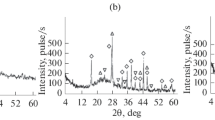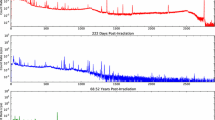Abstract
This paper describes a novel approach for preparation of scandium glass microspheres by combining both melt-quenching technique and an indigenously developed microwave approach. The microspheres were characterized for morphology, elemental composition, crystallinity and change in physical/chemical properties with temperature. The size of the prepared microspheres was found to be ranging from 500 to 1500 μm. The obtained glass microspheres were irradiated with thermal neutrons in a nuclear reactor to produce 46Sc radioisotope.







Similar content being viewed by others
References
Atroshchenko GN, Savinkov VI, Paleari A, Sarkisov PD, Sigaev VN (2012) Glassy microspheres with elevated yttrium oxide content for nuclear medicine. Glass Ceram 69:39–43
Kisieleski W, Svihla G, Brues AM (1950) Preparation of radioactive glass beads. Science 112:400–402
Sinha VR, Goyel V, Trehan A (2004) A radioactive microspheres in therapeutics. Pharmazie 59:419–426
Costa RF, Azevedo MBM, Nascimento N, Sene FF, Martinelli JR, Osso JA (2009) Production of microspheres labeled with Holmium-166 for liver cancer therapy: the preliminary experience at IPEN-CNEN/SP. International Nuclear Atlantic Conference—INAC 2009, Rio de Janeiro, Brazil, ISBN: 978-85-99141-03-8
Barros Filho EC, Martinelli JR, Sene FF, Squair PL, Osso Junior JA, (2013) Development and evaluation of holmium doped phosphate glass microspheres for selective internal radiotherapy. International Nuclear Atlantic Conference—INAC 2013, Recife, Brazil, ISBN: 978-85-99141-05-2
Radiotracer applications in industry-A Guidebook, IAEA-TECHDOC-423 (2004) International Atomic Energy Agency, Vienna, Austria
Charlton JS (ed) (1986) Radioisotope tracer techniques for problem solving in industrial plants. Leonard Hill, Philadelphia
Pant HJ, Kundu A, Nigam KDP (2001) Radiotracer applications in chemical process industry. Rev Chem Eng 17:165–252
Lin JS, Chen MM, Chao BT (1985) A novel radioactive particle tracking facility for measurement of solids motion gas fluidized beds. AIChE J 31:467–473
Larachi F, Chaouki J, Kennedy G, Dudukovic MP (1990) Radioactive particle tracking in multiphase reactors: principles and applications. Non-Invasive Monitoring of Multiphase Flows. Elsevier Science B. V, Amsterdam
Roy S, Larachib F, Al-Dahhana MH, Dudukovic MP (2002) Optimal design of radioactive particle tracking experiments for flow mapping in opaque multiphase reactors. Appl Radiat Isot 56:485–503
Dudukovic MP (2000) Opaque multiphase reactors: experimentation, modeling and troubleshooting. Oil Gas Sci Technol-Rev. IFP 55:135–158
Larachi F, Kennedy G, Chaouki J (1994) A γ-ray detection system for 3-D particle tracking in multiphase reactors. Nucl Instrum Methods A 338:568–576
Davarnejad R, Eshghipour R, Abdi J, DehkordI FB (2014) CFD modeling of a binary liquid-solid fluidized bed. Middle East J 19:1272–1279
Manual for Reactor Produced Radioisotopes, IAEA-TECHDOC-1340 (2003) International atomic Energy Agency, Vienna, Austria
Innovative technique of glass beads preparation in microwave oven (2013) Nuclear Recycle Group, BARC News letter. Nov−Dec 2013
Moon EM, Yang C, Yakovlev VV (2015) Microwave-induced temperature fields in cylindrical samples of graphite powder—experimental and modeling studies. Int J Heat Mass Transf 87:359–368
Chemat F, Poux M (2001) Microwave assisted pyrolysis of urea supported on graphite under solvent-free conditions. Tetrahedron Lett 42:3693–3695
Yunos MASM, Hussain SA, Yusoff HM, Abdullah J (2014) Preparation and quantification of radioactive particles for tracking hydrodynamic behaviour in multiphase reactors. Appl Mech Mater 625:509–516
Acknowledgments
The authors wish to thank to Dr. P. Sengupta, Material Science Division and Dr. S.C. Parida, Product Development Division of this center for their help in characterization and data interpretation of scandium oxide glass microspheres.
Author information
Authors and Affiliations
Corresponding author
Rights and permissions
About this article
Cite this article
Biswal, J., Joseph, A., Shah, J.G. et al. Preparation of 46Sc glass microspheres by combined melt-quenching and microwave methods for applications in radioactive particle tracking experiments. J Radioanal Nucl Chem 308, 335–340 (2016). https://doi.org/10.1007/s10967-015-4506-6
Received:
Published:
Issue Date:
DOI: https://doi.org/10.1007/s10967-015-4506-6




